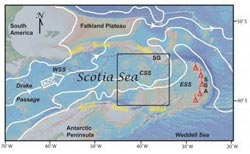Scientists cast doubt on theory of what triggered Antarctic glaciation

This is a physiographic map of the present-day Scotia Sea, Drake Passage and adjacent land masses. The white arrows show the present path of the several branches of the deep Antarctic Circumpolar Current (ACC) centered on its core. The area of study in the central Scotia Sea (CSS) is shown by the black box to the south of South Georgia island (SG). The volcano symbols mark the active South Sandwich volcanic arc (SSA). (WSS = western Scotia Sea; ESS = eastern Scotia Sea)<br><br>Credit: University of Texas at Austin<br>
Ian Dalziel, research professor at The University of Texas at Austin's Institute for Geophysics and professor in the Jackson School of Geosciences, and his colleagues report the findings today in an online edition of the journal Geology.
The Antarctic Circumpolar Current (ACC), an ocean current flowing clockwise around the entire continent, insulates Antarctica from warmer ocean water to the north, helping maintain the ice sheet. For several decades, scientists have surmised that the onset of a complete ACC played a critical role in the initial glaciation of the continent about 34 million years ago.
Now, rock samples from the central Scotia Sea near Antarctica reveal the remnants of a now-submerged volcanic arc that formed sometime before 28 million years ago and might have blocked the formation of the ACC until less than 12 million years ago. Hence, the onset of the ACC may not be related to the initial glaciation of Antarctica, but rather to the subsequent well-documented descent of the planet into a much colder “icehouse” glacial state.
“If you had sailed into the Scotia Sea 25 million years ago, you would have seen a scattering of volcanoes rising above the water,” says Dalziel. “They would have looked similar to the modern volcanic arc to the east, the South Sandwich Islands.”
Using multibeam sonar to map seafloor bathymetry, which is analogous to mapping the topography of the land surface, the team identified seafloor rises in the central Scotia Sea. They dredged the seafloor at various points on the rises and discovered volcanic rocks and sediments created from the weathering of volcanic rocks. These samples are distinct from normal ocean floor lavas and geochemically identical to the presently active South Sandwich Islands volcanic arc to the east of the Scotia Sea that today forms a barrier to the ACC, diverting it northward.
Using a technique known as argon isotopic dating, the researchers found that the samples range in age from about 28 million years to about 12 million years. The team interpreted these results as evidence that an ancient volcanic arc, referred to as the ancestral South Sandwich arc (ASSA), was active in the region during that time and probably much earlier. Because the samples were taken from the current seafloor surface and volcanic material accumulates from the bottom up, the researchers infer that much older volcanic rock lies beneath.
Combined with models of how the seafloor sinks vertically with the passage of time, the team posits that the ASSA originally rose above sea level and would have blocked deep ocean currents such as the ACC.
Two other lines of evidence support the notion that the ACC didn't begin until less than 12 million years ago. First, the northern Antarctic Peninsula and southern Patagonia didn't become glaciated until less than approximately 12 million years ago. And second, certain species of microscopic creatures called dinoflagellates that thrive in cold polar water began appearing in sediments off southwestern Africa around 11.1 million years ago, suggesting colder water began reaching that part of the Atlantic Ocean.
The research team also includes Larry Lawver and Marcy Davis at The University of Texas at Austin's Institute for Geophysics; Julian Pearce at Cardiff University (U.K.); P.F. Barker at the University of Birmingham (U.K.) (deceased); Alan Hastie at Cardiff University and the University of Edinburgh (U.K.); Dan Barfod at the Natural Environment Research Council's Argon Research Facility (U.K.); and Hans-Werner Schenke at the Alfred Wegener Institute (Germany).
Support was provided by the U.S. National Science Foundation's Office of Polar Programs, the U.K. Natural Environment Research Council, the Alfred Wegener Institute (Germany) and the British Antarctic Survey.
Media Contact
More Information:
http://www.utexas.eduAll latest news from the category: Earth Sciences
Earth Sciences (also referred to as Geosciences), which deals with basic issues surrounding our planet, plays a vital role in the area of energy and raw materials supply.
Earth Sciences comprises subjects such as geology, geography, geological informatics, paleontology, mineralogy, petrography, crystallography, geophysics, geodesy, glaciology, cartography, photogrammetry, meteorology and seismology, early-warning systems, earthquake research and polar research.
Newest articles

Silicon Carbide Innovation Alliance to drive industrial-scale semiconductor work
Known for its ability to withstand extreme environments and high voltages, silicon carbide (SiC) is a semiconducting material made up of silicon and carbon atoms arranged into crystals that is…

New SPECT/CT technique shows impressive biomarker identification
…offers increased access for prostate cancer patients. A novel SPECT/CT acquisition method can accurately detect radiopharmaceutical biodistribution in a convenient manner for prostate cancer patients, opening the door for more…

How 3D printers can give robots a soft touch
Soft skin coverings and touch sensors have emerged as a promising feature for robots that are both safer and more intuitive for human interaction, but they are expensive and difficult…




















